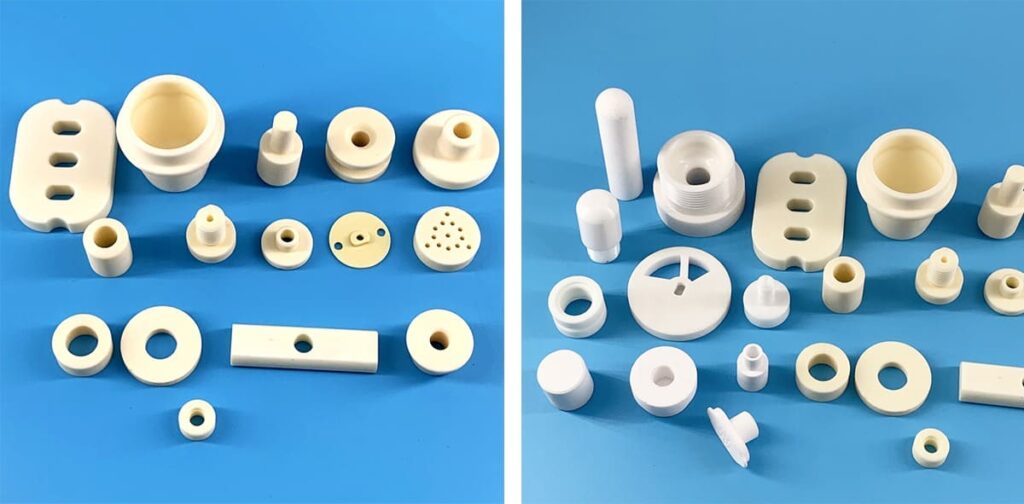What Are the Key Properties of Aluminum Oxide Ceramic?
Aluminum oxide ceramic, also known as alumina (Al2O3), is one of the most widely used advanced ceramic materials in the world. Its unique blend of mechanical, thermal, and electrical characteristics makes it a top choice for various demanding applications across industries, including electronics, aerospace, medical devices, and manufacturing. But what exactly gives alumina its exceptional performance, and how does it compare to other engineering materials? In this article, we’ll explore the key physical, mechanical, and thermal properties of alumina, look at its typical applications, and see how it stacks up against other advanced ceramics like zirconia and silicon nitride.
At Advanced Ceramic Hub, we specialize in high-density alumina ceramic, ensuring optimal performance for industrial and scientific applications.

What Are the Properties of Alumina?
The table below outlines the key properties of different grades of alumina ceramics:
Mechanical Properties:
| Material | Unit | 95% Al2O3 | 96% Al2O3 | 99% Al2O3 | 99.5% Al2O3 | 99.7% Al2O3 | 99.95% Al2O3 |
| Density | g/cm3 | 3.7 | 3.7 | 3.85 | 3.9 | 3.95 | 3.98 |
| Bending Strength (20℃) | Mpa | 300 | 300 | 330 | 360 | 380 | 500-600 |
| Compressive Strength (20℃) | Mpa | 2000 | 2000 | 2000 | 2350 | 2000 | 3500 |
| Young’s Modulus (20℃) | Gpa | 270 | 275 | 370 | 370 | 380 | 400 |
| Fracture Toughness (20℃) | MPam½ | 3.5 | 3.5 | 4 | 4 | 4 | 4.5 |
| Poisson’s Ratio(20℃) | \ | 0.2 | 0.22 | 0.22 | — | 0.23 | 0.23 |
| Mohs Hardness(20℃) | HRA | 8.0-8.5 | 8.0-8.5 | 8.5-9.0 | 9.0 | 9.0-9.5 | 9.0-9.5 |
| Vickers Hardness (HV1) | kg/mm2 | 1600 | 1600 | 1600 | 1650 | 1750 | 1800 |
Thermal Properties:
| Material | Unit | 95% Al2O3 | 96% Al2O3 | 99% Al2O3 | 99.5% Al2O3 | 99.7% Al2O3 | 99.95% Al2O3 |
| Thermal Expansion Coefficient (25-300 ℃) | 10-6K-1 | 6.5 | 6.5 | 7.6 | 7.2 | 7.2 | 7.5 |
| Thermal Conductivity (20℃) | W/mk | 20 | 25 | 27.5 | 32 | 32 | 45 |
| Thermal Shock Resistance | △T·℃ | 200 | 200 | 200 | 250 | — | 400 |
| Specific Heat Capacity | J/g·k | — | — | 0.79 | 0.78 | 0.79 | 0.80 |
| Max Operating Temperature (Oxygen Condition) | ℃ | 1600 | 1600 | 1650 | 1650 | 1700 | 1750 |
Electrical Properties:
| Material | Unit | 95% Al2O3 | 96% Al2O3 | 99% Al2O3 | 99.5% Al2O3 | 99.7% Al2O3 | 99.95% Al2O3 |
| Volume Resistivity (20℃) | Ω·cm | 1014 | 1014 | 1014 | 1014 | 1014 | 1014 |
| Dielectric Strength | KV/mm | 10 | 10 | 10 | 15 | 15 | 16 |
| Dielectric Constant (1 MHz, 25℃) | \ | 9 | 9 | 9.1 | 9.9 | 9.9 | 9.9 |
| Dielectric Loss Tangent (1MHz, 20℃) | tanδ | 3*10-4 | 2*10-4 | 3*10-4 | 1*10-4 | 1*10-4 | 1*10-4 |
These properties can vary slightly depending on the grade and form of alumina, such as sintered, hot-pressed, or injection-molded.
Request a custom quote for alumina ceramic.
Why Is Aluminum Oxide Ceramic So Widely Used?
Aluminum oxide ceramic stands out due to its high hardness, strong thermal stability, chemical inertness, and electrical insulation. These properties make it suitable for environments where metals or polymers would fail. From wear-resistant components in mechanical systems to substrates in microelectronics, alumina’s versatility is driven by its material characteristics.
How Does Alumina Perform in High-Temperature Environments?
Alumina is well-suited for high-temperature applications, with stability up to 1500°C in oxidizing environments. It maintains strength, dimensional integrity, and chemical inertness under extreme thermal cycling, making it a preferred material for furnace linings, heating elements, and thermal insulating parts.
| Property | Value | Impact on High-Temperature Performance |
| Maximum Service Temperature | Up to 1500°C | Enables long-term use in engines, furnaces, reactors |
| Melting Point | Above 2000°C | Prevents melting or deformation under extreme heat |
| Thermal Expansion Coefficient | 7–8 × 10⁻⁶ /°C | Minimizes thermal stress and cracking |
| Thermal Conductivity | 20–35 W/m·K | Supports efficient heat dissipation and insulation |
| Chemical Stability | Excellent in oxidizing and corrosive environments | Resists degradation, prolonging component life |
| Mechanical Strength (Flexural) | 300–600 MPa | Maintains load-bearing capacity under thermal cycling |
What Are Common Applications of Aluminum Oxide Ceramic?
- Electronics and Semiconductors: Alumina serves as an insulating substrate in integrated circuits and LED packages due to its excellent dielectric properties and thermal conductivity.
- Mechanical Parts: Used for wear-resistant seals, valve seats, and bearings in pumps and motors.
- Biomedical Devices: Thanks to its biocompatibility, alumina is used in dental implants, prosthetics, and surgical tools.
- Aerospace: Components such as nozzle liners, insulators, and support brackets benefit from alumina’s strength-to-weight ratio and thermal resistance.
- Chemical Processing: Its corrosion resistance is ideal for tubes, crucibles, and linings exposed to acids and alkalis.
Explore our high-quality alumina ceramics.
How Does Alumina Compare to Other Engineering Ceramics?
| Material | Hardness (HV) | Thermal Conductivity (W/m·K) | Dielectric Strength (kV/mm) | Max. Temperature (°C) |
| Alumina (Al2O3) | 1500 – 2000 | 20 – 35 | 12 – 15 | ~1500 |
| Zirconia (ZrO2) | 1000 – 1300 | 2 – 3 | 8 – 12 | ~1200 |
| Silicon Nitride | 1300 – 1600 | 15 – 30 | 10 – 14 | ~1400 |
| Boron Nitride | ~500 | 60 – 200 (depends on form) | 5 – 10 | ~1000 |
Alumina offers the best combination of mechanical and electrical performance among oxide ceramics, although silicon nitride may offer better fracture toughness.
Aluminum Oxide Ceramic Advantages
Aluminum oxide ceramic offers a powerful combination of durability, thermal resistance, and chemical stability that makes it a standout material across various industries. Its hardness and wear resistance help components last longer under harsh mechanical conditions, while its ability to withstand high temperatures ensures reliable performance in engines and high-heat environments. Additionally, its chemical inertness protects parts from corrosion and degradation, even when exposed to aggressive chemicals. This blend of properties, along with excellent electrical insulation and relatively low weight, makes aluminum oxide ceramic an excellent choice for applications demanding strength, stability, and longevity.
- Exceptional hardness and wear resistance
- High thermal stability with a melting point above 2000°C
- Strong chemical resistance to acids, alkalis, and molten salts
- Excellent electrical insulation and dielectric strength
- High mechanical strength and fracture toughness
- Low thermal expansion coefficient, reducing thermal stress
- Corrosion resistant for long-term durability
- Lightweight compared to metals, supporting design efficiency
- Biocompatible for safe use in medical applications
FAQ
| Question | Answer |
| Is aluminum oxide ceramic electrically insulating? | Yes, it offers excellent electrical insulation, making it suitable for high-voltage and electronic applications. |
| How resistant is aluminum oxide ceramic to corrosion? | It resists corrosion from acids, alkalis, and molten salts even at high temperatures. |
| Can aluminum oxide ceramic be used in biomedical applications? | Yes, it is biocompatible and commonly used for implants and dental devices. |
| Is aluminum oxide ceramic brittle? | While very hard and strong, it can be brittle under impact or sudden shock. |
| Can aluminum oxide ceramic be customized? | Yes, it can be manufactured with varying purity levels, densities, and shapes to suit specific needs. |
Why Choose Aluminum Oxide Ceramic?
Aluminum oxide ceramic combines excellent mechanical strength, electrical insulation, chemical resistance, and high-temperature performance. Its adaptability and proven reliability in critical applications make it a cornerstone material in modern engineering.
Advanced Ceramic Hub provides high-purity aluminum oxide ceramic parts and substrates designed for demanding applications. We offer custom geometries, tight tolerances, and consistent quality to meet your technical and performance needs.
Looking for high-quality alumina ceramics? Contact us today!
